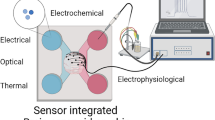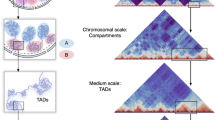Summary
It was recently reported (Endoh et al. 1981, Exp Cell Biol 49:272–277) that conditioned medium of neonatal mouse brain (CM-NB) inhibited the growth of mouse neuroblastoma cells. In this work we fractionated CM-NB by size exclusion high performance liquid chromatography, and separated two active principles (28,000 and 62,000 daltons) Each or a combination of the 28,000 and 62,000 dalton fractions showed a differential inhibitory effect on DNA synthesis or clonal growth of the three human lung cell lines: the normal diploid fibroblast WI38 cells were less susceptible than their simian virus 40-transformed VA13 cells and carcinoma A549 cells. This preferential growth-inhibition of malignant cells was also observed for rat fibroblast 3Y1 and its simian virus 40-transformed W3Y cells, and for two other normal and five other malignant cell lines. The growth-inhibitory activity of CM-NB or the 28,000 and 62,000 dalton fractions was lost by pronase, trypsin, tetrahydrofuran, acetonitrile, or dithiothreitol in the presence of guanidine, and also labile to heat, vigorous agitation, or freeze-thawing. The activity was also found in the conditioned medium of prenatal mouse brain, but not in either the conditioned medium of the adult brain and of the secondary culture of the neonatal brain, or in the homogenate and rinsing fluid of the neonatal brain. Thus the mouse brain at the terminal stage of ontogenesis liberates proteinaceous factors, which exhibit a preferential growth-inhibition of tumor or transformed cells and act on malignant cells of human and rodent origin.
Similar content being viewed by others
Abbreviations
- CM-NB:
-
the conditioned medium of the neonatal mouse brain
- NBCF:
-
neonatal mouse brain-derived carcinostatic factor
- Hepes:
-
4-(2-hydroxymethyl)-1-piperazine-ethanesulfonic acid
- MEM-H:
-
Eagle's minimum essential medium/10 mM Hepes
- MEM-HF:
-
MEM-H supplemented with 10% fetal calf serum
- HPLC:
-
high performance liquid chromatography
References
Abdel-Halim MS, Hamberg M, Sjöquist B, Änggårg E (1977) Identification of prostaglandin D2 as a major prostaglandin in homogenates of rat brain. Prostaglandins 14:633–643
Cowan WM, Wenger E (1967) Cell loss in the trochlear nucleus of the chick during normal development and after radical extirpation of the optic vesicle. J Exp Zool 164:267–279
Endoh E, Takeda S, Matsuzawa T (1981) Age-dependent inhibition of growth of neuroblastoma cells by mouse brain extract. Exp Cell Biol 49:272–277
Fukushima M, Kato T, Ueda R, Ota K, Narumiya S, Hayaishi O (1982) Prostaglandin D2, a potential antineoplastic agent. Biochem Biophys Res Commun 105:956–964
Gold P, Freedman SO (1965) Demonstration of tumor-specific antigens in human colonic carcinomata by immunological tolerance and absorption techniques. J Exp Med 121:439–462
Hamburger V (1975) Cell death in the development of the lateral motor column of the chick embryo. J Comp Neurol 160:535–546
Ishida A, Miwa N, Mizuno S (1983) Differential enhancement of cytotoxicity by combination of the carcinostatic agent benzaldehyde and hyperthermia in simian virus 40-transformed and normal cell lines. Cancer Res 43:4216–4220
Kato T, Tanaka R (1982) Cultures of glial cells as tools to study the glia-neuron interaction. Tissue Culture 8:217–224
Kinders RJ, Milencovic AG, Nordin P, Johnson TC (1980) Characterization of cell-surface glycopeptides from mouse cerebral cortex that inhibit cell growth and protein synthesis. Biochem J 190:605–614
Landmesser L, Piler G (1978) Interactions between neurons and their targets during in vivo synaptogenesis. Fed Proc 37:2016–2022
Miwa N, Mizuno S, Okamoto S (1983) Differential cytotoxicity to human lung normal diploid, virus-transformed and carcinoma cells by the antitumor antibiotics, auromomycin and macromomycin, and their non-protein chromophores. J Antibiot 36:715–720
Plotnikoff NP (1982) The central nervous system control of the immune system-enkephalins: antitumor activities. Psychopharmacol Bull 18:148
Quay WB, Payer TA, Banerji TK, Collins TJ (1982) Melatonin's inhibition of pituitary, adrenal, testicular and accessory gland growth in male golden hamsters: Pineal dependence and organ differences with shielding and intracranial surgery. J Neural Transm 53:59–73
Quiyada MG, Redding TM, Coy DH, Torres-Aleman I, Schally AV (1983) Inhibition of growth of a prolactin-secreting pituitary tumor in rats by analogs of luteinizing hormone-releasing hormone and somatostatin. Proc Natl Acad Sci USA 80:3485–3488
Redding TW, Schally AV (1984) Inhibition of growth of pancreatic carcinomas in animal models by analogs of hypothalamic hormones. Proc Natl Acad Sci USA 81:248–252
Rogers LA, Cowan WM (1973) The development of the mesencephalic nucleus of the trigeminal nerve in the chick. J Comp Neurol 147:291–320
Sakazaki Y, Kato T, Kato H, Ito J, Tanaka R, Naganawa N, Masaoka A, Tsunooka H (1983) Characterization and partial purification of neuroblastoma growth inhibitory factor from the culture medium of glioblasts. Brain Res 262:125–135
Scherama LH, Edwards PM, Schotman P (1984) Modulation of protein synthesis in a cell-free system derived from rat brain by corticotropin (ACTH), magnesium and spermine. J Neurosci Res 11:67–77
Simpson DL, Thorne DR, Loh HH (1977) Developmentally regulated lectin in neonatal rat brain. Nature 266:367–369
Author information
Authors and Affiliations
Additional information
This work was supported in part by a Research Grant from the Ministry of Education, Science and Culture, Japan
Rights and permissions
About this article
Cite this article
Miwa, N., Mizuno, S. Inhibition of tumor cell growth by protein factors derived from the developing mouse brain. J Cancer Res Clin Oncol 110, 196–202 (1985). https://doi.org/10.1007/BF00399273
Received:
Accepted:
Issue Date:
DOI: https://doi.org/10.1007/BF00399273




